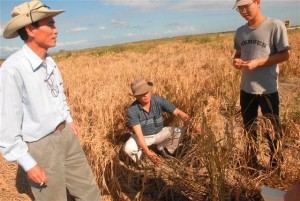 Over a year ago, the facility known as Casa del Azucarero (Sugar Worker’s House), in the former Natividad sugar mill, in southern Sancti Spiritus, began to be called Casa del Vietmanita (Vietnamese’s House), a name that might sound odd within the Cuban context.
Over a year ago, the facility known as Casa del Azucarero (Sugar Worker’s House), in the former Natividad sugar mill, in southern Sancti Spiritus, began to be called Casa del Vietmanita (Vietnamese’s House), a name that might sound odd within the Cuban context.
The shape of the building is the same; nevertheless, it quickly assimilated the Asian traditions brought by a group of experts from Viet Nam who arrived in this territory by virtue of a cooperation program intended to foster rice production in the region, specifically in Mapos cooperative.
Vietnamese technicians Houng Tran Xuan and Hung Nguyen, and translator Tuan Ngo Ngoc (Abel), who have already gone natives themselves, don’t hide their amazement at local nature and meteorological characteristics. “Here, the trees are always green, and the soil is excellent. This year, it has rained so much that we had to be evacuated twice in a thirty-days period of time”, they said.
With his 35 years experience in rice production, and having studied in countries with vast tradition on the subject like China, India, Thailand, Philippines, Indonesia, Malaysia, Japan, and the United States, Hung Nguyen is quite aware of the ups and downs of the production of rice in Mapos, the best rice cooperative of Sur del Jibaro agricultural complex last year.
“Cuba has similar or even higher potential than some of these countries –he explained. Unlike China or the United States, where winter temperatures can drop under cero degrees, cold is not that much in Cuba. According to investigations, it is possible to control the effect of plagues, there exist biological regulations, and birds help to control insects. On the other hand, you have large water fields, as well as irrigation and terrace systems”.
Nevertheless, there are also wrong practices that, according to the expert, must be pulled up like weed. In this respect he mentioned the unevenness of the ground, mostly due to the overuse of heavy machinery, which allows accumulation of water and further presence of weeds in the rice fields.
“We always speak plainly, and we feel no shame to advise because we want to teach”, said Houng Tran Xuan, who used to be a soldier in the war against the United States, and now works as an agricultural consultant. “When we express our ideas, what we say is taken into account, but then we are faced with difficulties to implement our proposals”, he added.
In his opinion, the problem is also related to the actual role and the autonomy granted to both the cooperative and the farmer producer. It is also related to the growing participation of this producer in the final results, as well as the connection of the top leaders with the workers. “Office meetings are not enough, it’s necessary to go to the field and to be concerned about rice production. What’s going on in the field must be heard with the ears and must be watched with the eyes”, he recommended.
Pedro Meneses, director of the Sancti Spiritus-based Territorial Station of Grain Investigations, considers himself to be a direct beneficiary of the Viet Nam-Cuba Cooperation Project. This project has allowed the acquisition of equipments to restart the production on quality seeds, and to fight the so-called red rice, a very difficult to control weed which is very similar to the developing rice plant.
 Escambray ENGLISH EDITION
Escambray ENGLISH EDITION





Escambray reserves the right to publish comments.